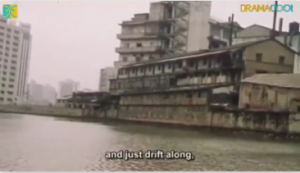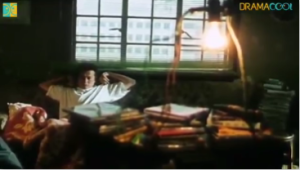Shanghai
27 Perceptions of Reality & Imagination of Life in Shanghai (Analysis of Suzhou River) by Jorge I. Alcocer
Jorge I. Alcocer
Abstract: Suzhou River (2000) is a Chinese drama and romance film about a tragic love story that depicts the grittiness of urban life in contemporary China. Taking place in modern Shanghai, the film follows the lives of four different people living in the city: the anonymous Narrator, Mei Mei, Madar, and Moudan. The film specifically follows their romantic relationships with one another with the Narrator being both our point of view in which the film is shot and the person telling the stories. The film depicts the blurred lines between the reality of the situations happening as well the imaginative and inconsistency of narrators recounting of the story. This essay argues that Suzhou River and its themes of perspective, reality and imagination are indicative of how director Lou Ye perceives Shanghai and causes the audience to question the reality of the situation in Shanghai.
Introduction
Suzhou River (2000), director Lou Ye’s second film, depicts a tragic love story taking place within modern day Shanghai. Upon release, Suzhou River was generally very well received, however it was not shown in China after Lou Ye screened the movie at the International film festival Rotterdam with permission from Chinese authorities and was subsequently banned from filmmaking for two years. However, since then the film has now been authorized in China. The film revolves around the romantic relationships between Madar, a motorcycle courier, Moudan, the daughter of a vodka smuggler, Mei Mei, a nightclub performer, and the Narrator/ videographer.
The Narrator

The story begins through the eyes of the narrator who is riding down Suzhou River and we see through his eyes the state of the riverside. We see shots of dilapidated buildings and the dirty, murky water. Our narrator states that Suzhou River tells multiple stories which makes it “the filthiest river”. This evokes a feeling in the audience of what we will be expecting to see throughout the film: a sense of murkiness and deterioration. The narrator says that he is a videographer and claims to film anything as long as he’s paid although “you might not like what you see because cameras don’t lie”.

The narrator is never shown physically and is only constructed through his monologues performed as a voiceover in certain scenes throughout the film. Making the story be told through his first-person view using his camera shows the importance of the camera points of view in constructing the story while capturing the narrator’s own personal perspective of the events unfolding before him. This gives the narrator the control and ability to manipulate what the audience is allowed to see, forcing onto us his limited perspective on the events. The narrator gives us a glimpse into his own reality; one which he cannot change. He is only given the ability to manipulate what he shows us but he himself cannot change those events that have happened.
When the narrator meets Mei Mei, and later starts going out with her, we see how the narrator’s perspective begins to be juxtaposed with a third person narrative as we see him telling the story of Mei Mei using his camera. A connection we can make between the film and the culture of Shanghai is Mei Mei’s character and how she ties in with the idea of the modern girl in Shanghai. She smokes, works at a nightclub, and drinks beer, characterizing many of the classifications used for modern girls who lived on speed and stimulation (The Man Who Was Treated as a Plaything, 14).


Madar & Moudan: Questioning of Reality
The narrator serves as the connecting point between the beginning story in first person to the now third person narrative telling of the story of Madar and Moudan. Being the one who narrates Madar’s and Moudan’s story allows him to create his own imagined story. We see examples of this when the narrator, whilst narrating the story, says things like “what else?” “Let me think” and “what if”. The use of these words shows how there is a lack of credibility and truth to how the narrator is retelling the story of Madar and Moudan. This creates an imagined and idealized setting in which Madar and Moudan now reside.
The third person points of view as well as the warmer lighting seen in certain scenes is used to dictate Madar and Moudan’s story as an intense romantic relationship between the two within a controlled atmospheric scene. This suggests that Madar and Moudan’s relationship is the stereotypical love story. However, it is only fiction and contrasts against the reality of the narrator and Mei Mei’s relationship. Their relationship, in contrast with Madar and Moudan’s, is characterized by closeup, almost suffocating shots that create a claustrophobic feeling to the narrator and Mei Mei’s relationship.
Narrator Vs Madar: Collision of Reality and Imagination
When Madar reenters into the current timeline along with the narrator, it allows for the plot of the Madar-Moudan story to commence once again, only this time Madar is the one in charge of telling the story and takes away the narrator’s control. At this point the lines between reality and imagination are starting to blur, as the narrator’s world, which we have perceived as reality, and Madar’s world, which we have perceived to be mostly fictional, are starting to collide and overlap with one another. In certain scenes, we see Madar assuming the 1st person point of view similar to our narrator’s point of view and we occasionally see them interacting within these scenes. Both characters share similar experiences as we see the narrator searching for Mei Mei within the crowds of Shanghai during her disappearances, and Madar who is searching for his lost lover Moudan. The narrator and Moudan are beginning to share similar points of views in the narrative, prompting us to question what is imagination and what is reality.
However, when Mei Mei begins to interact with Madar, Madar believes that Mei Mei is Moudan. Mei Mei and Moudan are almost exactly identical, different only in how they’re dressed and how they act (both characters are in fact played by the same actress Zhou Xun). Mei Mei at first pushes away Madar and rejects his idea that she is Moudan and doesn’t really believe Madar and Moudan’s story much less her own role within that story as a replacement for Moudan. In that sense, Mei Mei rejects the idea of such a romantic and almost fantastical love story, believing it to be fictional.
Death of the Third Person View
After the deaths of Madar and Moudan, we no longer see the third person point of view and the rest of the film plays out through the eyes of the narrator. The narrator is asked by the police to identify the bodies of Madar and Moudan and after seeing their bodies, runs off to find Mei Mei to tell her what happened. Mei Mei was pushed into a dramatized romantic scenario when she had a sexual encounter with Madar, believing that she could be Moudan and caving into the desire for a fantastical love story. However, she is brought back into reality when she sees the cold, dead bodies of Madar and Moudan, realizing that Madar never loved her but rather loved Moudan. Mei Mei now finds herself disillusioned about reality and love, discovering that reality does not have the capacity to harbor the extravagant and nonsensical thing that is love. Finally, after the conversation Mei Mei has with the narrator, which ties back to the beginning voice over, we find out that Mei Mei has disappeared, leaving behind a note that reads: “Find me if you love me.”
We then see the narrator on a boat drifting down the Suzhou River, drinking a bottle of Buffalo Grass Vodka with the affirmation that he is not Madar, and will not go find Mei Mei. In a way Madar represents a better idealized version of the narrator who does embark on a journey to find his long-lost lover. However, it is only an idealization from the narrator and not something he believes he can become since he is only a narrator, tasked with only showing us his experiences, unable to manipulate the story happening in front of him even if it happens to be his own which is why he sits and waits for the next story to start.
Perception of Shanghai
In accordance with how we view this film and connect it with modern day Shanghai there are a couple of key elements shown throughout the film that illustrate this comparison. For one, there are many shots in the film showing the dilapidated river side of Suzhou River which can cause a bit of a dissonance to the viewer as Shanghai is often perceived as a beautiful and wealthy city and commonly referred to as the “Paris of Asia”. Shanghai is also one of China’s largest cities responsible for generating a large amount of China’s wealth which in contrast, is not something we see represented in the film. This coincides with the overall message of the film and causes the audience to question our own perceptions of Shanghai as a city and the people living there. The unfortunate truth is that despite Shanghai being such a large, beautiful city, it is still stricken with poverty and economic polarization along with a suburbanization of impoverished areas in Shanghai resulting in an exclusion of lower class citizens from better employment, better housing opportunities, and better income.
Works Cited
“Economy of Shanghai.” Encyclopædia Britannica, Encyclopædia Britannica, Inc.,
https://www.britannica.com/place/Shanghai/Economy.
“Suzhou River.” 《苏州河》资料-中国-电影-优酷网,视频高清在线观看-又名:《Suzhou River》, https://list.youku.com/show/id_zcc034af0962411de83b1.html.
“Banned in China, Lou Ye to Make Film on Israeli-Palestinian Conflict.” The Guardian, Guardian News and Media, 28 Mar. 2007, https://www.theguardian.com/film/2007/mar/28/news1.
Lau, J.Cy. (2020). Suburbanisation of Poverty in Shanghai and Declining Ridership of Rail Services. In: Self-Organisation Shapes Travel Behaviours and Social Exclusion in Deprived Urban Neighbourhoods of China. Springer, Singapore. https://doi.org/10.1007/978-981-15-2252-9_6
Media Attributions
- suzhourivershot1
- meimei
- warmlighting
- Madar

